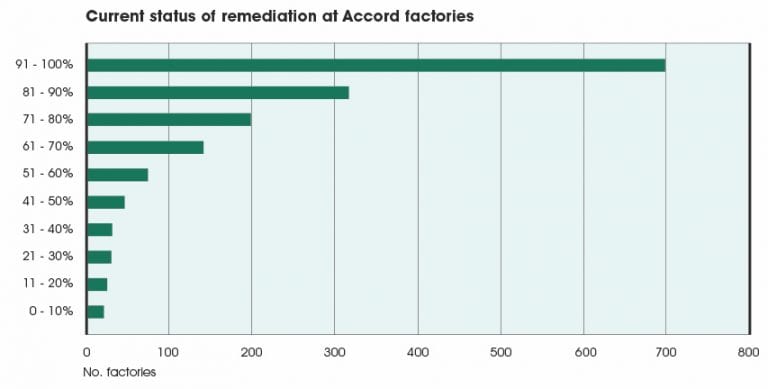Staggering yet a known fact – Bangladesh is the third-largest apparel manufacturing destination in the world, standing next to China and Vietnam, with over 6.3 per cent of the global market share. A few facts also reflect the dependency of the country’s economy on this sector. Markedly, the garment sector contributes to an overwhelming majority in driving the ‘economic’ wheel of Bangladesh – occupying over 82 per cent of the total export earnings. However, the ‘economic’ burden on this sector doesn’t take away a chunk of the great potential it has to cater to demands of the global apparel imports destinations like the USA, Europe, Canada or even Japan.
Here, we at Apparel Resources, bring to you the 8 enticing reasons why the country’s garment manufacturing industry poised to grow further and has great investment potential:
1. Quick Return, Protection:
Bangladesh offers up to 100 per cent foreign equity, especially in the Economic Zones (EZs). Additionally, as per the Government policy, an investor has the right to pull out the full investment, which is further transferrable with full profit sum. The country also allows up to 10 years of 100 per cent tax holiday to investors. Tax Holidays are often given to reduce sales taxes by local Governments and are now being commonly given as a stimulus for foreign investment.
So how do these benefits propel you to invest in the apparel sector? Well, the apparel sector in Bangladesh is currently considered as one of the best investment sectors as it offers a quicker return – ranging from 4 to 6 years – depending on your business strategies. The ratio of the return on the investment is high when compared to other businesses or industries.
Mohammed Nasir, Vice President (Finance) for Bangladesh Garment Manufacturers and Exporters’ Association (BGMEA), told Apparel Resources that it normally takes about 6 years to achieve the return if the business is good. “We could offer even better returns with progressions underway to improve infrastructural facilities like gas and electricity,” he underlined.
Furthermore, Bangladesh Economic Zone Authority (BEZA) states that the country allows full repatriation of capital and dividend and imposes no ceiling on Foreign Direct Investment (FDI). To investors investing US $ 75,000 or above, the country will be offering a resident visa as well. For those investing US $ 500,000 or more, ‘citizenship’ will be offered. Now that’s something!
2. Development of Industrial Zones bring in Ample Opportunities, Incentives
As much as Bangladesh is willing to open up to foreign investment, a plenty of investment opportunities are opening up in the new stretch that the Government has taken up for ‘industrialisation’.
Yes, you heard it right, ‘industrialisation’! BEZA is working to establish 100 Economic Zones (EZs), both public and private, which will include a majority of garment manufacturing factories, across the country by the year 2030. Notably, a number of private Economic Zones have already begun production activities at factories.
BEZA says, for investors, it will offer duty-free import of raw materials, 50 per cent exemption on stamp duty and registration fees, exemption of double taxation subjected to Double Taxation Agreement with 28 countries, foreign loans in compliance with existing laws, foreign currency accounts – for both local and joint venture industry and tax exemption on capital gains from transfer of shares as well.
3. Big Internal, External Markets
The global apparel market is predicted to be US $ 650 billion by 2020. And, the continual apparel export growth of Bangladesh is predicting opportunities to be a global leader in the export of garments – a fact that is driving the hopes of the apparel manufacturers and exporters, as China (who holds the No. 1 spot at present) is shifting its focus from garment manufacturing (the benefit of which is explained in the 8th point).
According to BGMEA, Bangladesh’s RMG export is increasing every year and the market share rose by 5.1 per cent, 5.9 per cent and 6.3 per cent through last three consecutive years, which gives hints of a bright future ahead for the country that is currently exporting to 130 countries all over the globe.
Additionally, Bangladesh is pushing for opening up newer markets in Australia, Korea, Japan, Brazil, Mexico, Argentina, Chile, Turkey and others. Shafiul Islam Mohiuddin, President for Federation of Bangladesh Chambers of Commerce and Industries (FBCCI), told Apparel Resources, that the country is currently stressing on exploring opportunities in Latin America and Russia markets, in particular.
When it comes down to the domestic market, Bangladesh Government is allowing apparel factories inside Export Processing Zones (EPZs), where foreign investment is being encouraged, to vend out to the local market. This offers a lucrative chance to the companies to take the advantage of the increasing demand in the domestic market of the country and improve their net revenue from this part of the world.
4. Cheap and Abundant Labour
‘Bangladesh is among the cheapest labour force in the world.’ And how can we say that? A recent news claimed that Prime Minister of Cambodia, which is also a popular apparel sourcing country, stated that minimum wages in the country may reach US $ 250/month by 2023. Meanwhile, Vietnam has also seen a rise in minimum to US $ 170 at present.
Coming back to Bangladesh, here the minimum wage for the 3.6 million labours currently stands at BDT 5,300 (around US $ 65) which make it the most lucrative destination when compared to other hubs.
‘People’ are the backbone of the country and the industry that employs the highest number who are supporting the sector to achieve US $ 50 billion export target in the coming years.
A recent survey of the Bangladesh Bureau of Statistics on Bangladesh’s 160 million plus population has found that 59.5 million are employed in some form or the other – 13.8 per cent under formal employment and the remaining 86.2 per cent informally employed. With parameters of people who are out of work and in a need of a job, the unemployed population stood at 2.6 million. In the rural region, the major population source for garment workers, the unemployment figure stands at 1.8 million. This shows ample opportunities for the garment industry to grow, (Note:) if the Government soon realises to make the best use of the available human resources.
However, the pressure to increase the workers’ pay and the Government’s willingness to support the move has put pressure on the industry. Still, it’s growing strongly, with an aim to resolve the issues internally, a new wage board has also been set up.
5. The GREENEST Manufacturing Hub
Bangladesh’s apparel sector has been reeling from an image crisis since some major industrial disasters like the Tazreen Fashions Fire and Rana Plaza Collapse. Well, the country has moved on… With 67 LEED (Leadership in Energy and Environmental Design) certified factories, Bangladesh has the highest in the world. The BGMEA has even said that over 220 more garment manufacturers have applied for LEED certification in the past, however, a report or inclusion of the same is yet to be made.
Markedly, the country has also understood the importance of being ‘compliant’ over the years and it is always good to learn from the past. Post the horrifying industrial disasters in the past, two inspection bodies – Accord on Fire and Building Safety in Bangladesh and Alliance for Bangladesh Worker Safety – were set up. The Accord covers around 1,600 factories and the Alliance around 666.

Today, the country which struggles a lot to portray its ‘safe’ image has 322 readymade garment factories or 88 per cent of Alliance-affiliated that have carried out the Corrective Action Plan. According to Alliance Executive Director James Moriarty, 290 factories required structural retrofitting five years back and 264 of those or 91 per cent have fully completed retrofitting, meaning their foundations, columns and beams are now able to meet the imposed load demands required of an industrial building.
Meanwhile, Accord states that it has witnessed 82 per cent overall remediation progress in the industry. Also, 127 factories have completed initial remediation whereas over 90 per cent remediation has been carried out at 699 factories.
We all believe in numbers, and these figures significantly highlight the efforts Bangladesh garment industry is making to emerge as a ‘compliant’ garment manufacturing hub.
6. Strong Backward, Building Forward Linkage
Over the years, policy formulation of Bangladesh Government and facilities given by the banks for the purchase of raw materials have added to the advantage of the country’s apparel industry. Supporting industries have been established and most of the raw materials required for production are readily available, which means procurement or sourcing of raw materials from other countries is minimal.
Around 1,430 textile mills are in operation currently with the capacity of yarn production at 2,100 million kg per year and the capacity of fabric production at 2,800 million metres. As presented at World Textile Conference, Mumbai (India), in September 2016, Bangladesh is meeting 85 per cent of knitted fabrics demand through local sourcing. China and a good number of other countries are seeking to invest in fibre, fabric and other industries in Bangladesh that is expected to build further on the backward linkage. Then what should you wait for to invest here?
It is pertinent to mention here that ‘Denim’, the most in-demand product (segment), is the area which is showing robust growth and a lot of investment is coming into the ‘production’ of denim as well. During a denim exposition held in Dhaka in November last year, Bangladesh Apparel Exchange revealed that about 60 per cent of denim fabric is being imported from abroad. Internally, Bangladesh has 30 denim mills producing 435 million yards of denim fabrics annually. Notably, Western brands such as H&M, Levi’s, Zara, River Island and Wrangler source denim from Bangladesh, while Marks & Spencer describes it as a ‘key market’ for denim production.
Atiqul Islam, President of Centre of Excellence for Bangladesh Apparel Industry (CEBAI), maintained that Bangladesh is strong in the backward linkage. But, where it lacks is forward linkage. His institution, about a year-old now, is seeking to do just that – conduct research into building value-added products, develop skills within the industry and develop product diversification. With advancements underway, the country encourages investment influx into the sector.
7. Duty Advantages in Export:
Being a member of Least Development Country (LDC) club, Bangladesh enjoys a duty-free market access or reduced tariff rates for apparel exports, including to its biggest export destination – the European Union. Bangladesh also enjoys Generalised System of Preference (GSP) facility to 38 countries including the 28 countries in the EU that are importing 90 per cent of garments from Bangladesh.
Though the country expects to graduate out of the LDC club soon, Bangladesh is optimistic that it will retain the duty-free access in the majority of the big export destinations. Bangladesh has moved the authorities of European Union and Canada in this regard with a positive response. Mohammed Nasir, Vice President (Finance) for BGMEA, told Apparel Resources that the garment manufacturers are seeking a duty-free access from various countries as the graduation from LDC will leave the manufacturers devoid of the facility but it is expected that the country will gain a positive response.
Also, there is a 5 per cent cash incentive in place for Bangladesh’s exporters to export to traditional markets like the US, Germany and Canada.
Meanwhile, Bangladesh Government is confident that the eligibility it has obtained to graduate out of LDC will not be affecting the duty advantages abroad. Commerce Minister Tofail Ahmed has said that Bangladesh will continue to receive duty advantages in its export destinations until 2027, which will help improve profit margins of the businesses operating.
8. Infrastructure
Bangladesh has been working extensively to improve the infrastructural facilities to provide the exporters with a hassle-free experience. The country is stressing on bettering its roads, power supply and port facilities. The Government of Bangladesh will build a floating terminal at the Chittagong Port’s outer anchorage to facilitate the movement of containers to and from the Pangoan Inland Container Terminal (PICT), and is also pushing for the establishment of more Inland Container Depots (ICDs).
The terminal will allow the unloading import containers from feeder vessels to smaller brown-water vessels able to head upriver to the PICT, which is located in a suburb of the capital Dhaka. This will not only help local exporters avoid congestion and accelerate deliveries but also save time (shortening the overall leadtime). Work is also being done on increasing the capacity of Chittagong Port which is responsible for the maximum shipments (90%) of apparel products from the country.
A first six-lane flyover has already been inaugurated at Mohipal in Feni, to further ease road communications between Dhaka and south-eastern port city of Chittagong.
The country is also reportedly working with countries like China and others to create a single long route that will connect entire Southeast Asia to Dhaka. Overhead roads are also on cards. Other than this, Bangladesh is focussing on enhancing its water transport facilities as well. A deep seaport Payra also has its master plan to be finalised soon. The aim is to reduce the pressure on Chittagong and Mongla Ports. As per a study by British company HR Wallingford & Consortium, the Payra Port will require around 7,000 acres of land.
The first US $ 400 million Regional Waterway Transport Project in Bangladesh has already commenced. The objective is to improve Inland Water Transport (IWT) efficiency along the Chittagong-Dhaka-Ashuganj Regional Corridor. Markedly, Inland Water Transport has also got a push over time in Bangladesh. The means is better cost arithmetic and materially less polluting in nature.
Conclusion: A ‘Hotspot’ of Sourcing
LightCastle Partners, an independent research firm in Bangladesh, in a report published in February 2018, identified the readymade garments or apparel industry as the ‘most growth potential sector’ in the coming decade. Even Goldman Sachs has included Bangladesh in the “Next 11” emerging countries to watch out for along with the BRIC countries (Brazil, Russia, India and China), while JP Morgan listed Bangladesh among its “Frontier Five” emerging economies worth investing in. On top of that, McKinsey & Company says Bangladesh will be the ‘top sourcing country’ for apparel products in the future.
To go by the figures that Apparel Resources has sourced, Bangladesh exported apparels worth US $ 29.32 billion in the year 2017, while Vietnam exported US $ 25 billion, Cambodia US $ 7 billion and India US $ 17.23 billion. In the coming future, the global market leader in apparel export – China with US $ 185 billion in exports – is expected to move its factories elsewhere. Experts in Bangladesh believe that there is a good chance that Bangladesh will be able to tap into the void that China will make as it has right plans in place to bolster the industry.
Stay tuned for more insightful pieces only on apparelresources.com!







